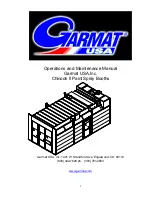
Surge Test Applications
12/3/2009 | 71-022 V6
D30R
56
Synchronous motor/generator
The synchronous stator is tested as a three phase induction motor. The rotating fields should
be tested individually. Before surge testing the stator remove the DC Leads to the brush
boxes or lift all of the brushes off the slip rings and short the slip rings for the rotating fields
together.
If the wave patterns are stable and they superimpose on the display, the windings are
identical, have no faults and the insulation of both coils is good.
Note
: One field can be tested and its surge wave pattern can be stored for reference. The
other fields can then be compared to this reference pattern in a procedure that is similar to
that of Two or more single coils.
Faults in synchronous motor/generators
Two types of faults may exist in synchronous motors and generators; pole piece and stator
winding faults.
Pole piece fault
Do not expect coils to compare exactly. Rotating fields or pole pieces are often not wound to
identical, exacting standards. If a fault does exist in the pole pieces of the test, the wave
pattern on the display will collapse in amplitude and a distinct shift to the left will occur,
signifying an increase in frequency (a decrease in inductance). This type of fault is usually
failure of the turn-to-turn insulation.
Stator winding fault
For a stator winding fault, if the wave pattern changes and becomes erratic during the test,
then intermittent shorting or arcing is occurring in the winding under test. Steady separation
of the wave patterns of the phases when recalled and compared indicates solid shorts. (See
Three phase motors).
Chiller motor testing
Before applying any test potential to a chiller motor, please review the manufacturer’s
instructions. These instructions usually recommend bleeding the vessel to atmospheric
pressure before applying a test potential.
Surge test procedures for chiller motors follow those outlined for three phase motors.
Field coils
When testing field coils follow the procedures outlined for testing Single phase motors and
two terminal devices and Synchronous motor/generator. The recommended surge test
voltage for DC fields is 600 V.
If the impedance of the coils is very low (few turns count, generally form coils with very low
resistance) the surge tester stand-alone may not adequately test the coils. The bar-to-bar,
low impedance test accessory from Baker Instrument Company, an SKF Group Company will
be necessary. Contact your Baker representative for information on this accessory and the
models that it operates with.
Armatures
While the series or shunt fields of the DC motor/generator are tested as a two terminal
device, the armature is tested differently.
There are two methods of surge testing armatures: the bar-to-bar surge test and the span
surge test. For ease of operation the use of a Footswitch is highly recommended.
Summary of Contents for D30R
Page 6: ...Table of Contents 12 3 2009 71 022 V6 D30R 6...
Page 12: ...Safety precautions CE compliance 12 3 2009 71 022 V6 D30R 12...
Page 24: ...Coil Resistance Testing 12 3 2009 71 022 V6 D30R 24...
Page 28: ...Principles of High Voltage DC Testing 12 3 2009 71 022 V6 D30R 28...
Page 38: ...High Voltage DC Testing 12 3 2009 71 022 V6 D30R 38...
Page 50: ...Surge Testing 12 3 2009 71 022 V6 D30R 50...
Page 70: ...Data Recording Retrieving 12 3 2009 71 022 V6 D30R 70...















































